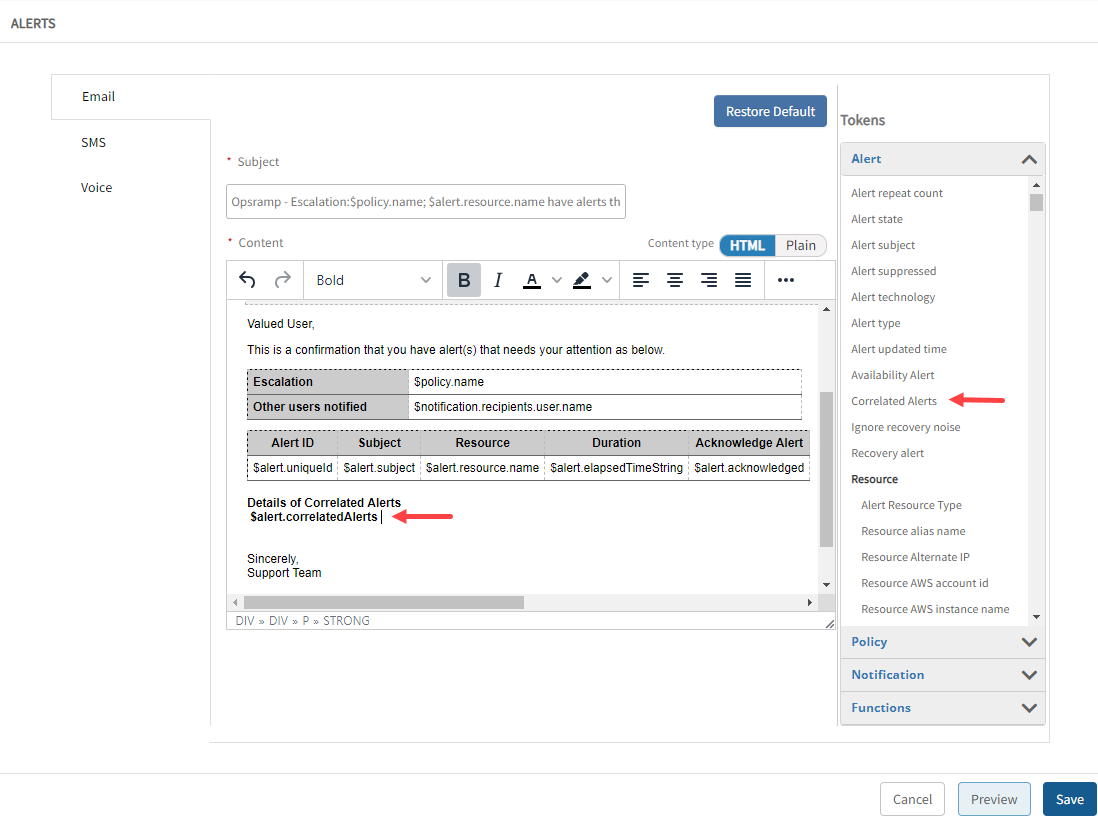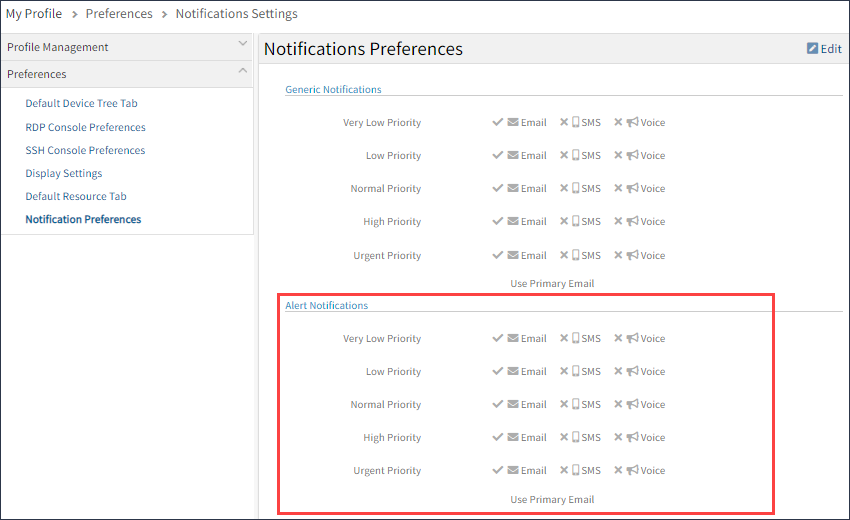Introduction
Notifications are attention-drawing messages that provide you the status of an event. The main purpose of creating notification is to notify a user, user group, or roster about the event. A notification can be sent using email, SMS, or voice and can also be acknowledged directly from the same channels.
Alerts can be escalated as a notification. The alert escalation is based on certain escalation rules. When the rules match, the alerts or the updates on the alerts are sent as notifications to a user, user group, or roster.
Note
Notification preferences, priority, and template are customizable.Creating notification template
You can configure the notification content of email, SMS, and voice notification for alerts. The template supports custom tokens to add the properties of the alerts.
To create notification template:
- From All Client, select a client.
- Go to Setup > Notifications > Alerts.
- Click Customize Notifications.
The Email, SMS, and Voice channels appear. - To create a Email notification template:
- Provide alert subject.
Note: Use Tokens to add desired alert details in the alert notifications, in addition to the default values.- Multiple tokens can be added by separating each token with a comma.
- For example, if the subject must contain the alert escalation policy name and the device group name,
provide the email subject with tokens
$policy.name; $alert.resource.deviceGroups.
- Customize the email content using the rich-text editor and tokens.
For example, if the details of all correlated alerts of an inference must be visible in the email body,
use the Correlated Alerts token as shown in the following screenshot.

Correlated Alerts Token
- Click Save.
- Provide alert subject.
- To create a SMS notification template:
- Customize the SMS text message as per your requirement using the tokens. Note: The maximum size of the message body is 1600 characters. But, globally an SMS can be sent only with 160 characters. Therefore, the message having more than 160 characters is split and sent as multiple messages.
- Click Save.
- To create a voice notification template:
- Customize the voice message body as per your requirement using the tokens.
- Click Save.
Alert notifications are sent using the appropriate notification channels as per the configured format or template.
Setting notification preferences
Notification preferences allow channels to be selected for sending alert notifications. This channel is determined by the notification priority.
Note
Preferences are applicable only for escalation notifications.Notification priority
An escalation notification carries a priority. This priority is used to determine the channel (email, SMS, or voice) where notifications are delivered.
For example, Policy P1 is configured to send Normal priority notifications (for all the matching alerts) to user A. Since the priority of the notification is Normal, user A prefers to receive all Normal notifications only using email and not using SMS or voice. In this case, user A would configure their notification preferences to receive the alerts using email.
Note
A partner or client user can configure the notification preferences from its user profile based on the notification priority. For example, if an administrator configured escalation notifications to a user. The user can choose to receive notifications on different channels (SMS, email, and voice) based on the notification priority.To configure the notification preferences:
- From Username, click My Profile.
- Go to Preferences > Notification Preferences.
- Click Edit, select the desired notification channels, and click save.

Alert Notification Preferences
Notes
- Primary email is the default email used for sending alert notifications.
- An alternative email can also be selected.
- SMS and voice notification is sent to the mobile number available in the user profile.
- Mobile number format should be prefixed with country code.
- Example: The mobile number format for the United States is
+1 523 232 4543.
- To provide mobile number, primary and alternate emails:
- Go to My Profile > Edit and provide the mobile number, primary, and alternate emails in the respective fields.
Enabling SMS and voice notification for an organization
SMS and Voice notification is available as an add-on for partners and clients with Event and Incident Management product package. If the SMS and Voice is a subscribed add-on for a partner, this is applicable for the client.